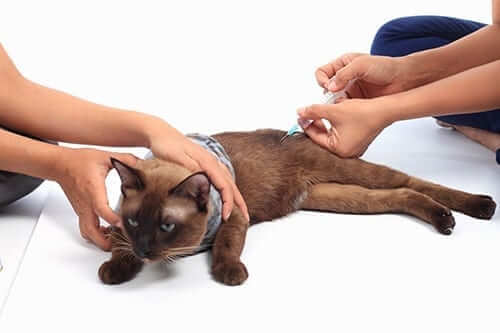In my general practice here in south Florida I usually diagnose a diabetic every month or 2. This past week I diagnosed 2 in one day! One of the biggest worries clients have (other than financial, of course), is giving injections to their beloved pet! Some pet owners are a natural with giving injections. Others need a little hand holding. Today we will revisit tips on giving an injection.
The best way to minimize the discomfort of an injection is to massage the skin. The nerves in the skin are stimulated by rubbing and it truly does minimize the sensation of the injection. When I give an injection I am usually petting the animal to alleviate anxiety of the pet. It is then second nature to massage the site where I will give the injection. After the injection, I massage the site some more while praising the pet. When you are good the pet doesn’t even notice the poke!
Another sleight of hand trick is to preoccupy Fluffy during the poke. I prefer to give the insulin injection as the pet is given a meal and digs into the chow bowl. Of course, for pets who are finicky or poor eaters this doesn’t work as well. For those pets who can’t imagine missing a meal this is very helpful.
Now, there are some places that hurt less when getting an injection. For animals the “scruff” (area over the shoulder blades along the back) is such a place. When owners of diabetic pets first start giving injections I show them how to give it in the scruff. As they become old pros, then they can start moving the injection site around to prevent any scarring or thickening of tissue from getting repeat injections in the same spot. I tell clients they can poke anywhere along a pet’s back. They might start going down one side this week and the other side of the pet next week.
When giving an injection, the easiest technique is to pick up the pet’s skin with a thumb and first two fingers. By tenting the skin and aiming just behind the thumb at a 45 or so degree angle you are pretty darned sure of getting the insulin into the pet instead of giving an “intra-fur” injection. Even seasoned doctors and nurses now and then miss and inject part or all of the insulin into the air or fur. Of course if this happens, don’t give more until the next insulin injection is due! If the pet got more than you estimated you could cause hypoglycemia by repeating it right away. A short period of a high blood glucose is much safer than a short period of a low blood glucose.
What if your diabetic is voluptuous or tubby? Well, that does make it harder to tent the skin but you can still try. If Fluffy has long fur, you can gently use that to lift up the skin to give you someplace to aim. When vets give an injection we will first pull back on the plunger of the syringe before injecting to make sure we aren’t in a blood vessel. In all honesty the odds are highly unlikely that you would happen upon a subcutaneous vessel; so as you are learning to give an injection I mostly have clients ignore this when giving insulin. Again, as clients become proficient in their technique they can aspirate before injecting.
As always, I enjoy hearing from our readers and clients. You can email me at [email protected]. I get a lot of our article topics from questions by readers.
NOTE: Consult your veterinarian to confirm that my recommendations are applicable for the health needs of your pet.







Dr. Sutton, I really appreciate your articles. My dog has had diabetes for about 8 months and I did not know I could give his insulin in other places other than his scruff. I have been rotating shoulders and he is very good about it but I’m sure he gets sore. I always massage afterwards and he likes that! Thanks Again
Thank you for your kind words. See? You inherently knew that rubbing it makes it feel better after the injection. 😉
Make the blood test & injection “fun” if possible. Annie loves to chase a ball, and she will bring her ball to the testing / injection location. She KNOWS when it’s testing time and will scamper off to get her ball to be ready! After the blood test, I toss her ball for her to chase. Same thing after the injection. It’s almost like she looks forward to the blood tests and injection 🙂
That is an excellent tip for everyone. Good job, Craig!